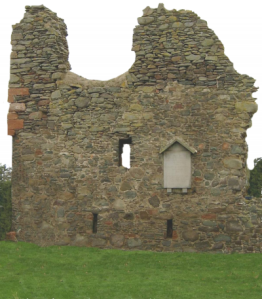The Legend of Thomas the Rhymer and the Queen of the Faeries
Associated with the village of Earlston was a curious 13th century bard and prophet, Thomas ‘The Rhymer’ Learmont. This remarkable man, whose name was Thomas of Erceldoune, lived in Learmont tower, just south of today’s Earlston (Erceldoune), near the mystical Eildon Hills, and was looked upon even in his own time as important and special.
Believed to be one of the first men to put pen to paper, legend has it that Thomas vanished for seven years with the Queen of the Faeries on a white steed. A stone lies inscribed to him in the local churchyard, and his old ruined Tower lies to the rear of the popular coffee shop. In the days of the early thirteenth century in Scotland the ballad or poem told the stories and recorded the history, and Thomas could hold an audience spellbound. Lord and Lady, Knight and knave, young and old, would hang on his every word, because Thomas could only tell the truth, and many of his rhymes were prophetic. Many of his prophecies are said to have come true.
He was born around 1220 and died about 1297, and his prophecies only appeared in literary form in the 1400’s, once he became a celebrated poet and prophet after his death. But while he lived, he was famous too, because of the fascinating events that led to him receiving his amazing gifts. At Huntly Burn, not far from Thomas’s tower, (now in ruins), there are some small falls that were covered in broadleaf hardwood trees when the poet was alive. Sadly, non-native conifers now stand where the hidden grove of oak and ash once stood. It was to this grove that Thomas loved to go and lie upon the bank under his favourite tree. Once, when he was young, he was enjoying his favoured spot when he saw the beautiful Queen of the faeries who lived in the Eildon Hills come riding along on her graceful white horse. She wore green silk and velvet and on her horse’s mane there hung fifty silver bells. Thomas bowed down to her beauty, entranced by her, but it was by no accident that they’d met for it was him she had come to see, and she asked him to kiss her, right where they were, under his favourite Eilden tree. Instantly in love, he agreed to go with her for seven years and they both rode into the Eildon Hills on her white steed as fast as the wind could carry them.
Once they had travelled far from mortal land, they eventually reached three paths. The Faerie Queen explained to Thomas where the three roads led in destiny and that they would be taking the road to her land, but warned him that whilst in her land whatever he saw and heard, he would never speak of or he would never get back to Learmont Tower, or Erceldoune. Thomas agreed, such was his love for her, and they continued their journey. Soon they came to a garden where the Faerie Queen picked an apple and gave it to Thomas, saying “ Take this for thy wages true Thomas, it will give thee a tongue that can never lie.” Thomas did indeed return to Learmont Tower about seven years later, wearing green and carrying a special harp. Though he told why he had gone away, he never spoke of anything that happened during his time away. He had returned with the gift of prophecy.
One of his most famous prophecies, recorded in the history of Scotland is his prediction at Dunbar Castle, given to the Earl Patrick, about the death of King Alexander the III. Thomas had predicted it on a stormy night, 18th March, 1286, the night before the king died. He also predicted the Battle of Bannockburn, the Jacobite uprisings, the Union of the Crowns of Scotland and England, and many, many more events. He is, too, the author of Sir Tristrem or Tristan, which is a valuable part of Celtic lore and the Arthurian legends. One prophecy relates to the site of Merlin’s grave showing the sign of the Union of the Crowns. According to Sir Walter Scott the grave of Merlin is “pointed out at Drummelziar, in Tweeddale, beneath an ancient thorn tree. On the east side of the churchyard the brook called the Pausayl falls into the Tweed”, and the prophesy states “when the Tweed and Pausayl join at Merlin’s grave, Scotland and England shall one Monarch have”. On the day of the coronation of James VI, the tweed overflowed and joined the Pausayl at the prophet Merlin’s grave. The Eilden Tree, Thomas’s favourite by the waterfall is no longer there, but the spot is marked. Beneath that tree, Thomas delivered many of his prophecies, and it was here, you will remember, that he met his beloved Queen.

